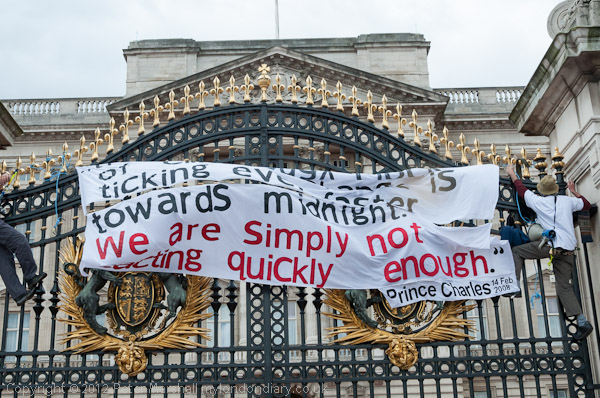
I’m not a big fan of rules of composition. My approach has always been rather more pragmatic, like “put the subject where it looks right” or as Minor White* put it rather more elegantly “Let the subject generate its own composition.” I suppose I might sometimes quibble about terms like subject or argue that everything in the frame is the subject; certainly that photographs are a very democratic space in which all pixels are equal, and that the photographer has to take the same responsibility for every one of them.
So I don’t go big on the “rule of thirds” or even the underlying “golden section” of which it is a crude simplification. But while photographing Climate Siren’s Royal Protest on the gates of Buckingham Palace, the unnoticed presence of a small lump of greasy substance on the filter of my 18-105mm lens in somewhere around that position (and appropriately it had a slightly golden translucence) did manage to make its presence felt in an important location in many of the pictures I took.
Here is an uncorrected short sequence of pictures which might have made a nice little story, when an officer decided to try to climb up and pull part of the banner down. His first try took Prince Charles’s name from a small attachment at the bottom of the the banner and then he got more ambitious:
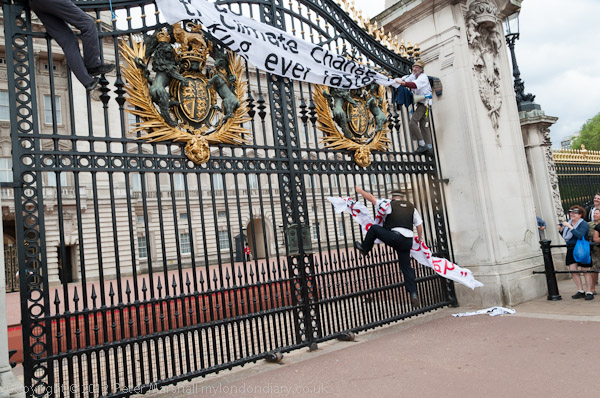
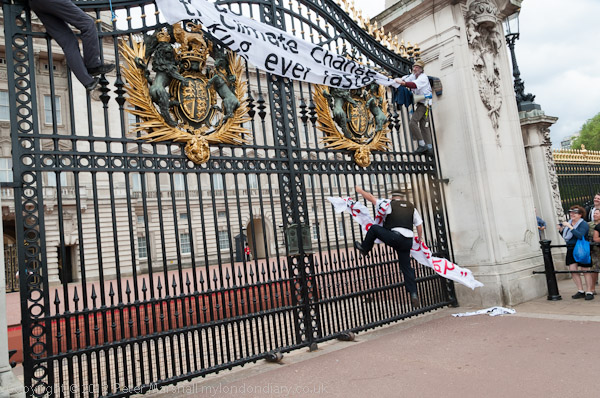

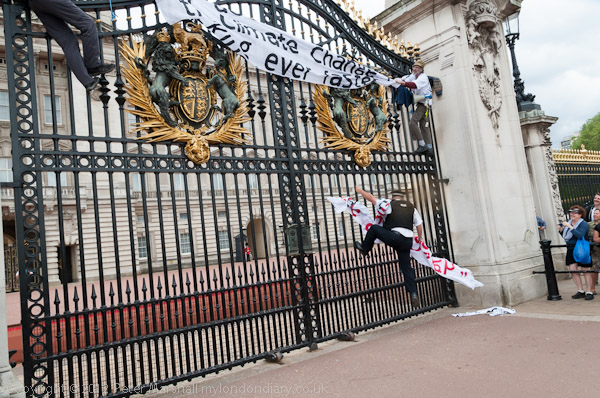
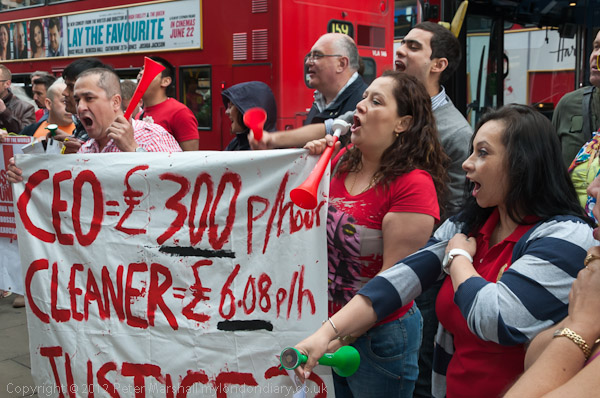


The final two frames are cropped and the ‘blob’ is larger and closer to the centre of the frame.
Whether bits of much on the front of the lens make a real mess of pictures does seem to very much depend on the subject matter and the aperture at which you are working. I still hadn’t noticed it later in the day when I was photographing another event and its actually hard to find on most of the pictures, taken at a wider aperture with subjects with more random detail. It shows up more in areas of even tone – such as the sky or the largely white banner held by the protesters – or on the regular high contrast black painted gates of the palace against the stone of the building behind.
It was a story I was in a hurry to file, as I’d been one of the first photographers present, having gone to join some of the members of the group at another location earlier. Unfortunately they had arrived at the palace just a few minutes too late for me to catch the start of the event, and there was little for me to take pictures of that wasn’t still happening when more press arrived after I left, as it apparently took around 2 hours before police got the four guys down off the gate. If I’d been able to send the sequence above off straight away it might have got used; not that they are great pictures, but they might make people laugh. Of course I took a few more frames before and after these, and the policeman was unhurt and later joked with me about his fall.
Dirt, or at least translucent dirt like this, diffuses light, and given time you can correct this to some extent in Lightroom with the adjustment brush. I find a combination of around contrast 25 and clarity 20 a good starting point, using a brush with fairly high degree of feathering (now added to my user presets with the title ‘grot-off’.) In suitable areas – as in most of these pictures – a little desaturation could be used to lessen the yellow shift I was getting, and in some images I could use a little of the complementary blue as LR4 enables you to brush with Color. There were one or two pictures where the splodge was in the sky and I could simply clone it out.
Look carefully at some of the images on My London Diary, most of which I’ve tried to correct, and you can see where the blob was, though in others I’ve been considerably more successful in getting rid of it. Every time after something like this happens I get paranoid about checking that my lenses are clean, but after a while without problems the effect wears off and I’ll forget again. Of course most days recently here we’ve had rain or at least showers, and so I’ve been more or less constantly wiping the lenses with a clean absorbent microfibre cloth (or sometimes a handkerchief or my shirt when I can’t find the cloth.)
I do have a standard set of checks on my way to take photographs, either while I’m packing my bag or often when I’m in a rush, on the train to London, although then I can’t do this when the train is crowded and I can’t get a seat.
- Check for any old images on CF cards and format them
- Set ISO to suitable value for likely light conditions
- Check quality is RAW (or RAW + JPEG if I need images fast)
- Check White Balance is Auto
- Clean Image sensor
- Check flash setting and flash compensation
- Check exposure compensation
- Check lens filter is clean, use Lens Pen if necessary to clean it
- Set Manual exposure to sensible settings, eg 1/60 f8
- Restore my standard custom settings
*perhaps the least widely quoted part of Minor White’s text from ‘Three Canons’ central to his major publication ‘ Mirrors Messages Manifestations‘.
Three Canons
Be still with yourself
Until the object of your attention
Affirms your presenceLet the Subject generate its own Composition
When the image mirrors the man
And the man mirrors the subject
Something might take over
Minor White 1968
________________________________________________________
My London Diary : Buildings of London : River Lea/Lee Valley : London’s Industrial Heritage
All photographs on this and my other sites, unless otherwise stated are by Peter Marshall and are available for reproduction or can be bought as prints.
To order prints or reproduce images
________________________________________________________